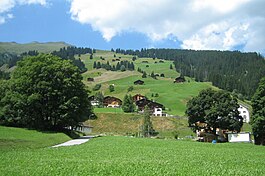Safien
| Safien | ||
|---|---|---|
| Former municipality of Switzerland | ||
 |
||
|
||
| Coordinates: 46°40′N 9°18′E / 46.667°N 9.300°ECoordinates: 46°40′N 9°18′E / 46.667°N 9.300°E | ||
| Country | Switzerland | |
| Canton | Graubünden | |
| District | Surselva | |
| Area | ||
| • Total | 100.6 km2 (38.8 sq mi) | |
| Elevation | 1,315 m (4,314 ft) | |
| Population (Dec 2011) | ||
| • Total | 294 | |
| • Density | 2.9/km2 (7.6/sq mi) | |
| Postal code | 7107 | |
| SFOS number | 3651 | |
| Surrounded by | Casti-Wergenstein, Duvin, Flerden, Mathon, Nufenen, Pitasch, Portein, Präz, Riein, Sankt Martin, Sarn, Splügen, Sufers, Tenna, Tschappina, Vals | |
| Twin towns | Bettingen (Switzerland) | |
| Website |
www SFSO statistics |
|
Safien is a former municipality in the district of Surselva in the Swiss canton of Graubünden. The municipalities of Valendas, Versam, Safien and Tenna merged on 1 January 2013 into the new municipality of Safiental.
Safien is first mentioned in 1219 as Stosavia.
Safien had an area, as of 2006[update], of 100.6 km2 (38.8 sq mi). Of this area, 45.6% is used for agricultural purposes, while 18.2% is forested. Of the rest of the land, 0.8% is settled (buildings or roads) and the remainder (35.4%) is non-productive (rivers, glaciers or mountains).
The former municipality was the capital of the Safien sub-district of the Surselva district in the mid and upper Safien valley. The only other municipality in the sub-district was Tenna, which occupied the lower Safien valley. The valley is drained by the Rabiusa river.
The former municipality consists of the village of Safien-Platz (elevation: 1,350 m (4,430 ft)) and scattered hamlets and single farm houses throughout the valley.
The blazon of the municipal coat of arms is Gules a Cross gyronny Argent and Sable It is based on the simple design of the sub-district, with different colors.
Safien had a population (as of 2011) of 294. As of 2008[update], 0.3% of the population was made up of foreign nationals. Over the last 10 years the population has decreased at a rate of -15%. Most of the population (as of 2000[update]) speaks German (96.1%), with Italian being second most common ( 1.6%) and Albanian being third ( 1.6%).
...
Wikipedia




